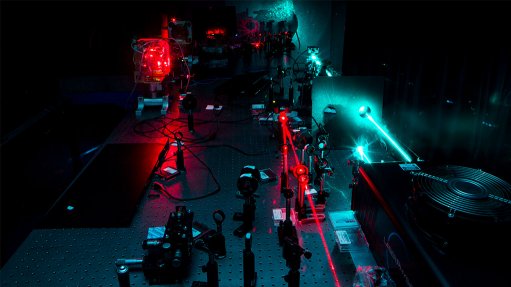
OAM ENTANGLEMENT RIG
Entanglement swapping allows the establishment of entanglement between two distant points
Photo by: University of the Witswatersrand School of Physics
A team of Scottish and South African researchers demonstrated that quantum correlations could be established between previously independent photons and that this could be used to send information across a virtual link.
In research published in science journal Nature Communications in September, the team from Heriot-Watt University, in Scotland, led by Professor Jonathan Leach, and the University of the Witwatersrand, led by Professor Andrew Forbes, performed the first experimental demonstration of entanglement swapping and teleportation of orbital angular momentum (OAM) patterns of light, which is a crucial step towards realising a quantum repeater for high-dimensional entangled states.
Importantly, the scheme is scalable to higher dimensions, paving the way for long-distance quantum communication with high information capacity.
Quantum communication over long distances with two-dimensional states has been demonstrated in free space and fibre optics, as well as over distances exceeding 1 200 km between satellites. However, using only two states reduces the information capacity of the photons – hence, the link is secure but slow.
“Making quantum communication over long distances secure and fast requires a higher-dimensional alphabet by, for example, using patterns of light of which there are an infinite number. One such pattern set is the OAM of light. Increased bit rates can be achieved by using OAM as the carrier of information.
“However, such photon states decay when transmitted over long distances, owing to, for example, mode coupling in fibre optic networks or turbulence in free space, thus necessitating a way to amplify the signal. Conventional amplification is not possible at the quantum scale, but it is possible to create a quantum repeater, which is comparable to optical fibre repeaters in classical optical networks,” explains Forbes.
An integral part of a quantum repeater is the ability to entangle two photons that have never interacted – a process referred to as “entanglement swapping”. This is accomplished by interfering two photons from independent entangled pairs, resulting in the remaining two photons becoming entangled.
This allows the establishment of entanglement between two distant points without requiring one photon to travel the entire distance, thus reducing the effects of decay and loss. The information of one photon can be transferred to the other, a process called teleportation. It also means that line of sight between the two points is not needed.
High-bit rate long-distance quantum communication relies on high-dimensional quantum entanglement as a core resource. Entanglement swapping may be used to generate remote quantum correlations between particles that have not interacted, the core ingredient of a quantum repeater, similar to repeaters in optical fibre networks, the journal entry abstract states.
“We demonstrate entanglement swapping of multiple OAM states of light. Our approach does not distinguish between different antisymmetric states, and thus entanglement swapping occurs for several thousand pairs of spatial light modes simultaneously.”